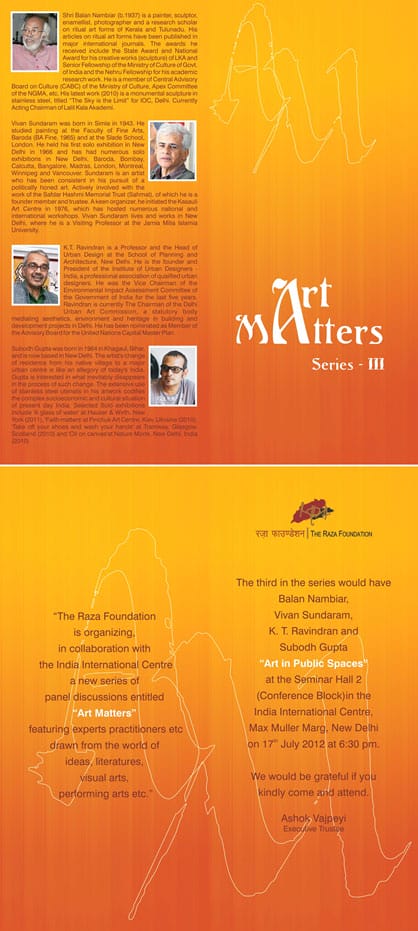
10-Jul-2012 12:00 AM
2341
The contemporary times stand witness to a constant deterioration of meaning of art and manipulation of theoretical social and political concepts as well as their practical significance. Whether they are questions as serious as social and political concerns of human rights or social exclusion affecting a dignified human survival, or as sensitive as the waning of interest in classical art forms, they call for an urgent need to revisit and discuss the prevalent conceptions.
Art has its unique way of reviving our soul from deadening monotonous routines through its multiple intricate expressions. Forming a singular perception of art or attributing a definitive meaning to it often reduces art from its fascinating complexity and expressive charm. This reductive approach confines art to its modernist understanding, which then fails to take cognizance of the artistic abstraction expressed through different forms and styles.
The Raza Foundation through its series ‘Art Matters’ provides a platform for open discussion on such issues. It endeavors not only to release the true essence of art from the clutches of definitive modernist approach in order to grasp myriad ways of extolling art, but also to stir up debate on the changing meanings of social and political theoretical concepts like rights, justice, liberty, citizenship, etc. Well known, renowned scholars and practitioners from all the diverse fields of arts, dance, music, social science, poetry, and so on are invited for this purpose.
Here, we publish the third panel discussion of ‘Art Matters’, titled ‘Art in Public Spaces’ featuring Vivan Sundaram, Balan Nambiar, K. T. Ravindran and Subodh Gupta.
Vivan Sundaram is one of Indian’s most prolific artists and active political voices. His own artistic practice which moved from painting during his college years to engaging with everything from readymades, photographs, videos to sculptural installation has been crucial in the definition and development of installation as a practice in the country. A great amount of his energy has been directed into developing platforms for robust political dialogue and collaborative spaces for artists and intellectuals. His work with activism during his student years later manifested into his work with Safdar Hashmi Memorial Trust (Sahmat), of which he is a founder member and trustee. His initiatives at the Kasauli Art Centre in 1976 saw some of the most important artists come together and set the pedagogical frameworks within which contemporary art in India can be understood.
Balan Nambiar is one of India's leading contemporary artists and also a research scholar on ritual art forms of the west coast of South India. His sculptures are in mild steel, concrete, stone and stainless steel. Monumental sculptures are his hallmark. His enamel paintings are done with jewellery enamel colours, silver and gold on copper base. He has received awards both for creative works and academic research.
T. Ravindran, Professor and Head of Urban Design at the School of Planning and Architecture of New Delhi, his work focuses on the development of cities, and more specifically on the inclusion and conservation of heritage buildings in modern urban spaces. Founder and president of the Institute of Urban Designers, he teaches classes such as “Urban Morphology” and “Humanizing Cities”. Under these baroque terms, there is a necessary architectural, geographical and sociological assessment of the explosion of urban landscapes. Amidst the obvious anomie in the development of Indian cities, KT Ravindran offers theoretical and practical solutions to the architectural and geopolitical issues which have appeared in the last two decades.
Subodh Gupta was born in 1964 in Khagaul, Bihar, and studied at the College of Art, Patna (1983-1988) before moving to New Delhi, where he continues to live and work. Trained as a painter, he went on to experiment with a variety of media, which culminated in his first installation in 1996 entitled Twenty-nine Mornings. Gupta is mostly known for working with everyday objects that are ubiquitous throughout India, such as the mass-produced steel kitchen utensils used in virtually every home in the country. From such ordinary items the artist produces sculptures that reflect on the economic transformations of his homeland while acknowledging the reach of contemporary art and its ideas. While stainless steel is Gupta’s signature medium, he has also masterfully executed works in bronze, marble, brass and wood while dialoguing with found and manipulated objects that encapsulate multiple meanings and reflect on the circumstances of contemporary India.
The event was organised at the Indian International Centre on 17th of July 2012.